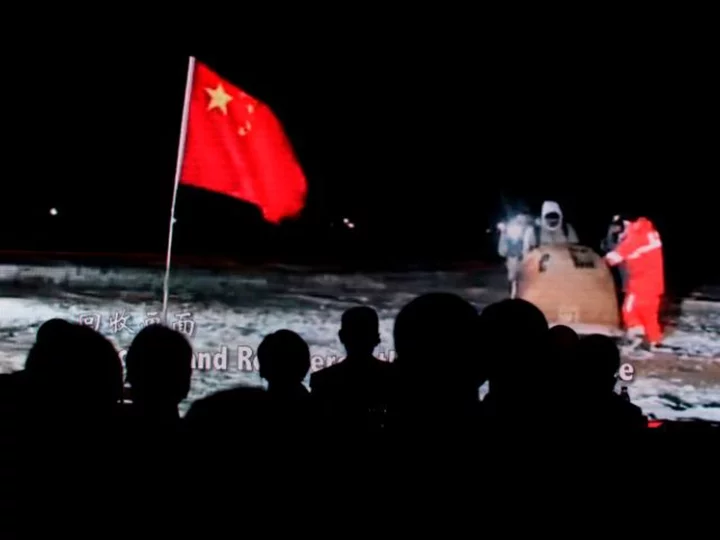China's lunar mission to bring back the first samples ever collected from the moon's far side is on schedule for next year, officials say, as Beijing ramps up its ambitious plan to send astronauts to the moon this decade and build an international lunar research station.
Preparations for the next planned mission -- known as Chang'e-6 -- were progressing smoothly, China's National Space Administration (CNSA) said in a statement last week, adding that the mission's accompanying relay satellite would be deployed in the first half of next year.
This week, CNSA also looked ahead to its Chang'e-8 mission slated for 2028, with Chinese officials on Monday calling for increased global collaboration for the unmanned lunar expedition during the International Astronautical Congress in Baku, Azerbaijan.
The Chinese expedition in 2028 would welcome joint "mission-level" projects with other countries and international organizations, according to an accompanying document released on the CNSA website.
This means China and international partners could work together on spacecraft launch and orbit operation, conduct spacecraft-to-spacecraft "interactions," and jointly explore the surface of the moon, the document said.
The spacecraft would also make room for 200 kilograms (440 pounds) of foreign science payloads, the agency said on its website. This could allow overseas partners to conduct lunar research by "piggybacking" off the mission, Chinese state media said.
China expects both upcoming missions, and the Chang'e-7 slated for 2026, to produce valuable data toward constructing a permanent international research station on the lunar south pole by 2040 -- part of Beijing's wider push to become a major space power.
Those efforts have seen China become the first country to send a rover to the far side of the moon in 2019, complete construction of its orbital Tiangong space station last year, and announce plans to become only the second country to land a manned mission on the moon by 2030.
Expanding Beijing's international ties through space collaboration is also part of that plan -- though so far only a handful of countries are reported to have joined onto its planned lunar research station. They include Russia, Venezuela and South Africa, according to Chinese state media.
China is not alone in elevating its space program and lunar ambitions as multiple countries eye the potential scientific benefit, national prestige and access to resources and further deep space exploration that successful moon missions could bring.
Last month, India landed its Chandrayaan-3 spacecraft on the moon, becoming only the fourth nation to accomplish the feat, with its lunar landing reaching closer to the moon's south pole than any other spacecraft in history.
That same week, Russia's first lunar mission in decades ended in failure with its Luna 25 spacecraft crashing into the moon's surface.
The United States has also boosted its lunar program -- launching the first test flight in 2022 under its Artemis program, which aims to return US astronauts to the moon in 2025 and build a scientific base camp there, with NASA also eying the lunar south pole.
Like China, the US has also been gathering international partners, with more than two dozen countries signing on to its Artemis Accords norms for "peaceful exploration of deep space." China is not among the current signatories.
China's upcoming moon missions
Beijing's Chang'e-6 mission next year will deepen understanding of the moon's far side, collecting samples following 10 previous missions to the near side facing Earth, the CSNA said in a statement Friday, coinciding with Mid-Autumn Festival -- a Chinese national holiday associated with the moon.
"Such samples will enable scientists to advance their studies about the far side ... (and) analyze the samples' composition to broaden knowledge about the moon," Hu Hao, a senior official working on the Chang'e-6 mission, told Chinese state media last week.
The spacecraft is slated to touch down in the far side's South Pole-Aitken Basin and collect dust and rock samples there, Hu was cited as saying, referring to a major lunar landform of high scientific interest.
The far side of the moon, which can't be seen from Earth, is covered in craters, but unlike the near side isn't dominated by large lunar mare, or darker imprints of ancient lava flows -- a difference that puzzles scientists.
The Chang'e-6 spacecraft will also carry payloads and satellites from four international partners, according to the CNSA.
Those include a French-made instrument to detect radon gas, a negative ion detector from the European Space Agency, an Italian laser corner reflector to calibrate radar systems, and Pakistan's CubeSat, a square-shaped miniature satellite, it said.
The mission is expected to be followed by the Chang'e-7 in 2026, which aims to search for lunar resources on the moon's south pole, and Chang'e-8 two years later, which could look at how to utilize lunar materials, officials have said.
China has launched five robotic probes since 2007. Its last mission, Chang'e-5, landed on the moon in December 2020 and returned with samples of lunar rocks and soil.

